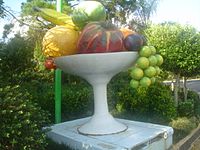Bilpin, New South Wales facts for kids
Quick facts for kids BilpinNew South Wales |
|||||||||||||||
|---|---|---|---|---|---|---|---|---|---|---|---|---|---|---|---|

Bilpin Post Office
|
|||||||||||||||
| Population | 665 (2016 census) | ||||||||||||||
| Postcode(s) | 2758 | ||||||||||||||
| Elevation | 623 m (2,044 ft) | ||||||||||||||
| Location |
|
||||||||||||||
| LGA(s) | City of Hawkesbury | ||||||||||||||
| State electorate(s) | Hawkesbury | ||||||||||||||
| Federal Division(s) | Macquarie | ||||||||||||||
|
|||||||||||||||
Bilpin is a small town located in the beautiful Blue Mountains of New South Wales, Australia. It's found west of Sydney along the historic Bells Line of Road. This area is part of the City of Hawkesbury local government region.
Bilpin is widely known as the "Land of the Mountain Apple." The rich soil here is perfect for growing fruit, especially apples. You'll often see roadside stalls selling fresh produce, particularly during summer. Bilpin apples and their juice are famous all over Australia. People who live in Bilpin tend to stay a long time, showing how much they love their community.
Contents
History
Early Days and Aboriginal Connections
Historians have different ideas about whether Bilpin is on Dharug or Darkingung Aboriginal land. However, it's known that the Dharug people lived on the plains, and the Darkingung people lived in the mountains. The name "Bilpin" itself is an Aboriginal word that might mean "mountain." An Aboriginal guide named Pulpin was active in 1816, and his name could also be linked to how Bilpin got its name.
In 1823, a young man named Archibald Bell, Jr., who was only 19, was shown a route from Richmond to Mount Tomah. This path went through what is now Bilpin. He was guided by two Darug men, Emery and Cogy. Later that year, Archibald Bell found a way across to what is now Lithgow. In 1834, a surveyor named Felton Mathew and his wife camped at a farm in Bilpin.
Local Authors
Bilpin has inspired some talented writers. Hesba Brinsmead, a well-known children's author, grew up in Bilpin. She wrote several books set in the area, including Longtime Passing (1971). This book even won the Children's Book Council of Australia award. Another local author, Meredyth Hungerford, who was related to Hesba Brinsmead, wrote books like "Bilpin: the Apple Country" and "Exploring the Blue Mountains."
Activities and Community Life
The Bilpin Community Hall is a very important place for everyone in town. It hosts a Farmer's Market every Saturday morning, where you can find fresh local produce. The hall also holds the yearly Spring Flower show and an annual quilt exhibition.
The community hall is also where the Bilpin preschool operates. Many local groups meet there, such as the Gardening Club, the Farmers' Association, and the Quilting Club.
Bilpin School
Bilpin has a small school that first opened in 1927. In 2015, about 67 students attended the school. The school has its own vegetable gardens and even a chicken coop! It also works closely with the local Environmental Education Centre to help students learn about nature.
Getting Around
Bilpin Coaches helps local children get to and from Bilpin school each day. They also offer services for students attending other schools nearby. For seniors and people who need help with transport, Hawkesbury Community Transport provides a weekly bus service to Richmond.
Tourist Attractions
Bilpin has become a popular place for tourists to visit. Many roadside stalls sell fresh fruits and homemade goods. You can also visit orchards like Pine Crest Orchard, where you can pick your own fruit. Another famous spot is The Bilpin Fruit Bowl, which features the world's largest fruit bowl as a fun roadside attraction!
Demographics
In 2011, Bilpin had a population of 665 people. The people living in Bilpin are a bit older than the average for Australia. Their average age was 45 years, compared to the national average of 38.
About 18.5% of the population were children under 15 years old. People aged 65 and over made up 17.6% of the population. Most people (79.8%) living in Bilpin were born in Australia. Also, 87.7% of people spoke only English at home.




